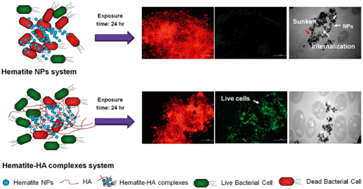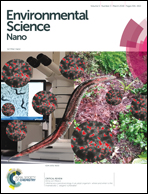Metabolism, survival, and gene expression of Pseudomonas putida to hematite nanoparticles mediated by surface-bound humic acid†
Abstract
Natural organic matter (NOM) is likely to coat nanoparticles (NPs) in the environment and poses distinct effects on the viability of microorganisms. However, such a topic has not been well investigated; hence, this study was designed to explore the interactions of NOM, NPs, and bacteria in a model system and, specifically, the influence of surface-bound humic acid (HA) on the toxicity of hematite NPs to Pseudomonas putida. Results showed that pure hematite NPs could inhibit the bacterial growth with a median lethal concentration (24 h LC50) of 23.58 mg L−1, while surface-bound HA could significantly mitigate the toxicity of hematite with the highest LC50 of 4774.23 mg L−1, which were corroborated by the transcriptional regulation of Pseudomonas putida cell activity-related genes. Co-precipitation experiments and transmission electron microscopy observations revealed that surface-bound HA prevented the adhesion of hematite to the cells and limited cell internalization. Compared to hematite NPs, the generation of intracellular reactive oxygen species (ROS) and the expression of oxidative stress genes were significantly inhibited in hematite surface-bound HA systems. The prevention of adhesion and inhibition of ROS production could account for the HA-mitigated nanotoxicity. Interfacial interactions between hematite and bacteria were also evaluated on the basis of the Derjaguin–Landau–Verwey–Overbeek (DLVO) theory, suggesting that the more adhesive conditions resulted in greater toxicity and the more repulsive conditions resulted in a reduced toxicity of the model microorganism. The results of this study serve as a platform to better understand the interactions between bacteria or bacterial biofilms and minerals in the natural environment.



 Please wait while we load your content...
Please wait while we load your content...